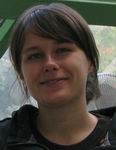 |
Alumna
Dr. Annegret Larsen, geb.Kranz (Germany, 1980)
Staatsexamen in Geography and German alarsen@ecology.uni-kiel.de
|
| PhD project |
 Past Natural and Anthropogenically Altered Sediment Flux in the Spessart Mountains – a Central European Landscape Past Natural and Anthropogenically Altered Sediment Flux in the Spessart Mountains – a Central European Landscape
The Late Quaternary surface processes of a steep gully system in Central Europe occur mainly as multiple gully erosion and sedimentation cycles. These cycles depend largely on the relation between sediment supply and sediment transport capacity. The gully thalweg was aggraded during the Younger Dryas as a result of high sediment supply from the slopes and a diminished transport capacity in the channel instigated by a reduction in vegetation during this time. For the majority of the Holocene time period, phases of headward gully incision are the dominant process, which occurred as a result of internal hydrological and geomorphic thresholds under well-vegetated conditions. During this time sediment was also deposited on the gully fan.
The onset of intense human agricultural activity during medieval times led to large scale slope erosion due to vegetation removal and subsequent thalweg re-aggradation. In comparison with the natural hillslope sediment flux during the Younger Dryas, erosion from human driven slope instability was found to be at least ~2.3 times more efficient. More specifically, it is clear that different land use techniques on the catchment slopes, as reconstructed from the analysis of soil charcoal analysis, are the dominant control on overall hillslope erosion rates. The lowest erosion rate was found in an area where only small agricultural fields were maintained. The recovery of most of the catchment vegetation in the last ~500 years has re-stabilised the slopes and modified the internal threshold of sediment supply/sediment transport capacity, such that the gully has begun a new incision phase. Hence, sediment is again transported from the thalweg into the gully fan and floodplain of the adjacent trunk stream.
The quantification of sediment fluxes reveals that the most recent and continuing phase of sediment export is also the most geomorphically significant for the trunk stream, since it is the only time in the last ~15 000 years that a large percentage of the thalweg erosion budget is able to be incorporated into the alluvium of trunk streams. Because the gully system itself has a large storage capacity, sediment delivery from small headwater catchments to trunk streams generally does not occur until vegetation has re-stabilised the slopes, and allows sediment transport capacity to increase. The recent changes to high sediment delivery to the floodplain and adjacent streams are a possible explanation for the observed floodplain aggradation of trunk streams and the resulting changes of the river regime. However, it is also suggested that valley bottom damming for various purposes throughout this time is also a major factor controlling this large change in river behavior. The investigation of this direct human impact on the river landscapes of Central Europe remains a critical avenue of further research.
Dissertation available on:
http://eldiss.uni-kiel.de/macau/receive/dissertation_diss_00007685
|
| Post-doc project |
The Legacy of Historic Damming in Central European Floodplains. |
| Research interests |
My research interests focus on the impact of humans and climate change on earth surface processes and how this in turn influences the morphology of the landscape. We know from palaeo-records that the landscapes of central Europe have undergone significant modification during the Holocence, and I use an interdisciplinary approach to understand why the land surface has changed and how it developed during time. Whilst I undertake detailed geomorphologic and soil profile investigations, they are often not enough to provide insight into the cause and effect relationships between humans, climate, and the sedimentary archive. Vegetation, which is crucial for landscape stability, is therefore often the missing link. I aim to fill this gap as much as possible by working on charcoal extracts from my sediment archives to reconstruct the vegetation composition preserved in different periods. Together with dating techniques (14C and OSL), archaeological records, and historic written sources, my research project aims to provide detailed reconstructions of the time scale, initiation, events, and terminations of landscape changes and how these alterations have effects for humans today. |
| Post PhD Position |
Position at the Institute for Ecosystem Research, CAU Kiel. |
| Education |
Since April 2008
Member of the Graduate School “Human Development in Landscapes” at the Christian-
Albrechts-University Kiel.
October 2001-July 2006
Bayerische Julius-Maximilians-University of Würzburg, Germany. Geography and German language
and literature studies for teaching certificate (high-schools). Leaving certificate: German
first state examination; title of final thesis: “Räumliche Erfassung und kulturhistorische Bewertung
von Schlackenhalden im Nordspessart und deren methodisch-didaktische Aufarbeitung als Kulturweg“
October 1999-September 2001
Otto-Friedrich-University, Bamberg, Germany. Studies of Geography (both: natural and cultural),
German language and literature studies, science of education for teaching certificate (highschools).
Leaving certificate: intermediate examination. |
| Work experience |
March 2007 - February 2008
Research associate of professorship for Geomorphology of University of Bayreuth, Germany.
Activities: Composing a research project in Geoarcheology; teaching students (weekly courses
and excursions).
September 2006 - February 2007
Teacher on probation at Röntgen-Gymnasium, Würzburg, Germany. |
| Selected publications |
2008
Bork, H.-R., Kranz, A.: Die Jahrtausendflut des Jahres 1342 prägt Deutschland – Neue Forschungsergebnisse aus dem Einzuggebiet des Mains. Jahrbuch der Wetterauischen Gesellschaft für die gesamte Naturkunde 2. Bd.:119 – 129. |


